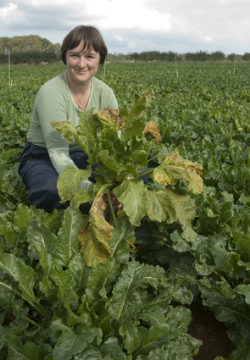
Sugar beet growers who made two fungicide applications over the summer could be set to reap the rewards this year, according to Syngenta Technical Manager, Beth Hall. After limited growth over the dry summer, trials in the eastern counties are showing significant extra greening and disease control from a two spray strategy, with healthier plants taking full advantage of late sunshine and moisture.
"Rust levels have increased dramatically in the wet and warm conditions," reports Mrs Hall. "Untreated crops are showing 100% infection with a rapid loss of leaf area, when there is still significant scope for further root bulking and increased sugar content during the autumn period.
"The single Spyrale treatments applied in July are holding up well under the intense disease pressure, with a few rust lesions beginning to appear on some plants. But it's the crops which received a second application in mid-August that are still looking incredibly healthy, with little or no infection," she adds.
"With this extension of the plant's photosynthetic capacity there is the potential to hold off lifting and really boost the sugar content and yields from late summer sunshine."
Mrs Hall believes the independent trials, being undertaken by Armstrong Fisher in Cambridgeshire and Lincolnshire, will provide valuable evidence to help growers decide on the most appropriate use of a one or two spray Spyrale programme.
With global warming and more seasons typically finishing with prolonged warm sunny conditions, there may be more opportunity for the later applications in the future.
British Sugar agronomist, Robin Limb, believes that with the recent rain and sunshine there's plenty more left in the yield bank yet. "Beet is still growing well and, if the leaf is healthy, will go on adding yield right through the autumn. Crops can put on an additional 25% of adjusted yield from mid-September, with sugar content increasing by 0.2 - 0.4% a week through to November."
Growers may need to start lifting to fulfill delivery schedules, get following crops drilled or avoid the risk of late harvest in wet soils, but wherever possible Mr Limb urges them to lift as close as possible to delivery into the factory. "There's a real chance to maximise yield in the field and minimise respiration losses in the clamp, which will both help to increase returns," he added.
